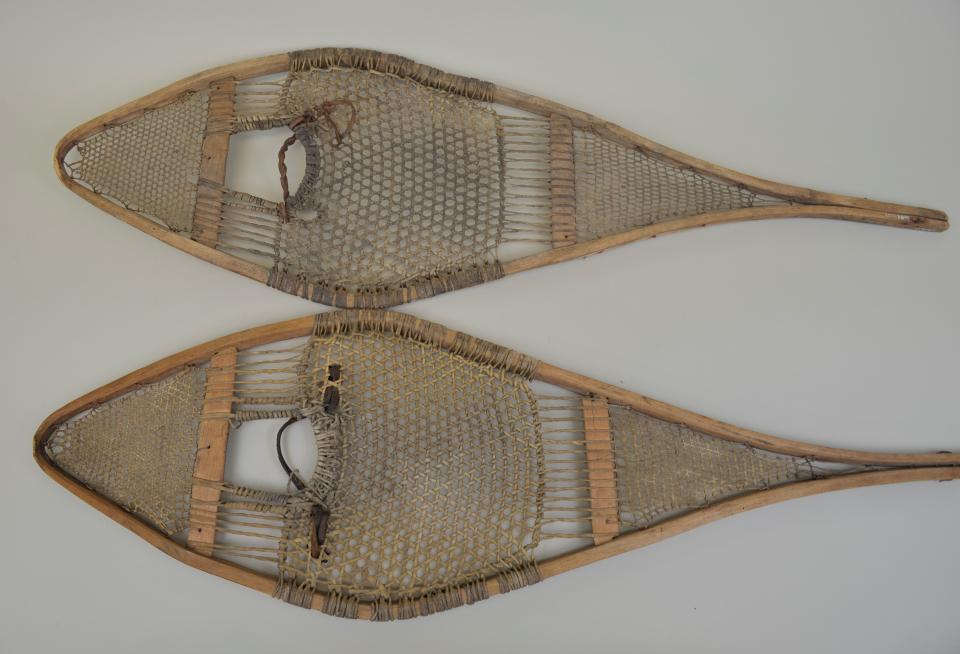
a- Length 93.9cm x Width 27.2cm x Height 2.0cm
b- Length 92.9cm x Width 27.2cm x Height 1.9cm
Pair of snowshoes made of wood, rawhide, leather, and red string. The snowshoes are shaped in the 'Huron' style that is wider through the middle and long and narrow towards the bottom. There are two thin horizontal pieces of wood going across the width of each shoe at the top and towards the bottom of the area for the wearer's foot to rest. There is also a piece of thin leather on each shoe towards the middle which would go over the wearer's foot in order to keep the snowshoe in place. The long thin shape at the bottom of the shoe acts as a rudder in order to help the shoes walk in a straight line, as well as helping the wearer stay balanced and have their weight dispersed equally.
Despite the lack of archaeological evidence, the earliest snowshoes are believed to have originated in what is now central Asia more than 6,000 years ago. These forerunners of the snowshoe are referred to as snow skis. Basically, they amounted to a slab of wood lashed to the bottom of each of the wearer’s feet. As tribes began to migrate from central Asia, those tribes that went west to present-day northern Europe developed Nordic skis (the Nordic ski did not find its way across the Atlantic until the early 1800s). Meanwhile, those tribes that migrated east across the Bering Sea land bridge (Beringia) into what is now North America developed snowshoes.
But the evolution of snowshoes did not stop there. North America is comprised of a vast array of environments, so it only makes sense that snow in Alaska differs greatly from snow in the prairies, which in turn differs from snow along the East Coast. These differences in snow and landscape resulted in snowshoes evolving into a myriad of regional styles. As a result, a snowshoe in Alaska differs from a snowshoe on the prairies, and so on.
Simply put, snowshoe design evolved to meet the environmental needs and intended use of the wearer. Another factor that impacted snowshoe design and evolution was the availability of materials. White ash, prized for its strength and pliability, is the preferred framing material, but hickory, spruce, birch, elm and larch have also been used. Babiche – untanned caribou, moose, or deer hide strips – was used for the lacing.
There are four main traditional styles of snowshoe: Huron, Alaskan, Ojibwa and Bear Paw. There are also a number of lesser-known styles of traditional snowshoes, some of which are: Pickerel, Beaver Tail, Attikamek, Elbow and Green Mountain Bear Paw.
Traditionally, the task of making snowshoes was a job shared by men and women; men made the frames while women laced the deck area with babiche. Frames were formed by bending lengths of wood that had been split and cut to length from straight logs of the preferred wood at hand. Each snowshoe was made from a single length of wood, with the exception being Ojibwa-styled snowshoes, which used two lengths per snowshoe. The lengths are then steamed and bent into the appropriate shape using a form. Crossbars, usually two, were added and the tails were pinned together.
After the snowshoes had dried and holes were drilled, the women would take over, weaving the babiche lacing that filled the frames. Depending on the type of snow that the snowshoes were intended to be used upon, the lacing would be either extremely fine, as is the case for snowshoes produced in Labrador and Eastern Quebec where the snow is deep and dry, or much looser, as is the case in Alaska. Snowshoes also differed from season to season; with a looser weave being used on snowshoes intended for use in wet spring snow and slush. The lacing was so fine in many eastern snowshoes, with intricate designs woven into the deck that they are considered pieces of art.
